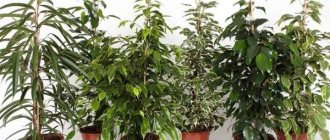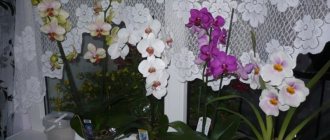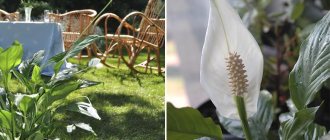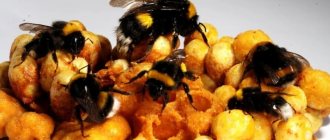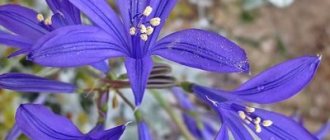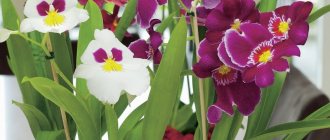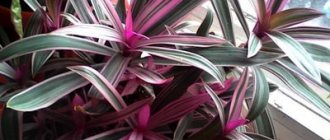Ficus is probably the most popular indoor flower. We became so familiar with its minimalistic beauty that we stopped noticing how beautiful ficus trees are. However, a ficus flower can make any room visually more comfortable - from an apartment to an office.
The value of ficus is not only in aesthetics. It is a natural “air purifier”, absorbing harmful substances that household appliances inevitably produce. This flower is especially good at “fighting” carcinogens that enter the air when frying foods. Ficuses promote sound sleep for the residents of the house, and also protect the “owners” from influenza and ARVI, preventing the growth of bacteria.
We have prepared a selection of the most beautiful ficus trees especially for you. Every novice plant grower will be able to find a flower to their liking.
Aspera
Aspera is an evergreen tree. With good care, Aspera can grow up to 1 meter in height.
The main advantage of this ficus is its leaves. They are quite large, slightly rough to the touch. Their interesting coloring interspersed with white, dark green and light green colors resembles a marble pattern.
Ficus Aspera is quite expensive and quite capricious to care for, but such unsurpassed beauty must certainly require sacrifice.
Ficus Arrowhead
Finally, the fourth creeping variety - f. sagitatta gets its name from its long, sharp, arrow-shaped leaves. A monochromatic plant looks aesthetically pleasing, but the variegated subspecies looks more impressive.
Grow on shelves, furniture tops and in hanging baskets. As it grows, the sagitatta will lower its branches, and if you provide it with hooks, it will crawl along a wall or other surface.
Ficus plants are amazing plants! They can be large or small-leaved, grow in the form of trees or shrubs, and have slender or swollen trunks. Even if you have only unpretentious ficus trees in your apartment, you can achieve variety in your “indoor landscape.”
Ficus Krishna (Bengal)
Typically, Krishna ficus trees are used for office decoration. Not every indoor plant lover has enough space in their apartment to keep a three-meter flower. But if you own a private home, buying a Bengal ficus can be an excellent investment.
In Bangladesh, Sri Lanka and India, the Bengal ficus is considered a symbol of eternity. It is part of a religious cult and is often used to decorate temples. This is a very specific tree that only the most extraordinary owners can appreciate.
Ficus Ginseng
Perhaps one of the most decorative species is ginseng or microcarpa. Among flower lovers it has the “underground” name of bonsai, because... the bizarre curved trunk resembles this variant of plant formation. The lower part of the stem is bare, on top there is a dense crown of dense glossy leaves.
For successful cultivation of f. ginseng microcarpa requires a semi-shaded place without drafts. If a flower blows, it can shed all its leaves and lose its decorative effect.
Ficus benjamina
One of the most popular types of this wonderful plant. Ficus benjamina can decorate even a completely simple interior.
If you contact a landscaping specialist, most likely he will immediately offer you to purchase a Benjamin ficus. Unlike most spectacular plants, this ficus does not require special care. He will easily forgive you if you completely forgot to water it during the deadline, and this will not affect the appearance of the plant in any way. The only requirement for those who are going to purchase this miracle is to provide the ficus with a sufficient amount of sunlight.
Ficus flowering
Ficuses can be grown both in an apartment and on a personal plot. But everyone who has purchased this beautiful plant asks the question: can a ficus bloom?
One of the relatives of the ficus is the fig, and, as is known, this plant blooms and bears fruit well only in regions with a hot climate. The same can be said about ficus. To make it produce flower stalks, it is necessary to provide the plant with an abundance of sunlight, a very hot climate and create an atmosphere that is 100% close to natural conditions.
A plant grown in a harsh climate will never bloom, even if it is provided with additional lighting and heating.
What to do if the ficus does not bloom? All that remains is to admire the beauty of the ficus flower from the photo.
The plant can only bloom in a greenhouse
“Binnendiya Ali” (willow leaf)
This ficus received its name in honor of the man who first discovered this amazing plant - Simon Benedict. This ficus is quite popular and has already managed to win the hearts of thousands of Russian plant growers. Ficus Benedict, as it is also called, is quite unpretentious in care - and therefore especially loved by those who are not used to spending too much time caring for indoor flowers.
Binnendiya Ali is quite different from other varieties of ficus. What makes it especially beautiful are the unusually shaped leaves - narrow and pointed at the tips. The color of the ficus can be either monochromatic or variegated, depending on the variety.
Features of care
This exotic green pet is not at all capricious to care for at home, it grows very quickly and can hit the ceiling just a couple of years after rooting. In order for a tree to captivate others with its well-groomed appearance, it is enough to create certain conditions for it.
The soil
The soil for ficus willow must be fertile, loose, breathable, and not retain excess moisture. Alkaline and acidic soil types are not suitable. Cuttings can be planted in ready-made soils for palm trees and ficus trees, or you can create a soil mixture yourself. To do this, you need to take 2 parts of turf, 2 parts of rotted leaves, one part each of sand, humus and peat.
Feeding
Fertilizers should be applied in the spring and summer months, alternating mineral and organic. Twice a month, you can add complex fertilizer intended for indoor flowers to the water for irrigation. With the same regularity, you can spray the leaves with a weak solution for feeding. During the dormant period (late autumn and winter), feeding is stopped.
Microclimate
The most suitable place for Binnendijk varieties is away from direct sunlight and radiators. The most comfortable air temperature in the room in summer is + 20 -25 ° C, in winter - + 16-20 ° C. The air in the room should not stagnate. But you cannot open a window for ventilation, near which there is a pot or tub with a tree, or hang an air conditioner over it: the ficus also does not tolerate direct drafts.
Humidity
Watering should be moderate, with settled water at room temperature. In winter, watering frequency is once a week, from spring to autumn - three times a week. Stagnation of moisture in the pot should not be allowed, this leads to rotting of the roots. It is recommended to spray the leaves regularly, especially when the air in the room is overheated.
The need for watering is determined by the condition of the soil in the pot - it should dry to a depth of 3-5 cm. If the surface layer of soil crumbles easily in your hands and does not stick, water the ficus. Water is poured on top of the earthen clod in small portions in several stages. After half an hour, the water that has flowed into the pan is drained, and the pan and the bottom of the pot are wiped dry.
Lighting
Ficus Binnendijka Ali comes from subtropical forests, so it loves good lighting. It is also noteworthy that the warmer the room, the more light it needs. In the natural habitat, this feature is associated with the change of seasons. Variegated varieties are suitable for diffused light, trees with dark green leaves are suitable for partial shade. The preferred place on the windowsill is the south or east side.
Transfer
Young trees grow quickly, and every year they need to be transplanted into a new pot 3-4 cm larger than the previous one with a complete replacement of the soil. It is advisable that the pot be new and sterile. If the container has already been used, wash it thoroughly and disinfect it. Adult plants have to be replanted less frequently, every 3 years, using the transshipment method. Very large specimens have a negative attitude towards replanting; they are left in place, but the top layer of soil must be renewed every year.
The best time for replanting is the beginning of spring, when the tree awakens from dormancy. Drainage is poured into the bottom of the pot. A ficus is placed on it, and soil is evenly poured around it on all sides. This is done regardless of whether the tree is replanted with a complete replacement of the soil or by transshipment with a lump of root soil. You need to carefully ensure that the barrel stands up straight, without tilting in any direction. Then the soil in the pot is watered abundantly, and the transplanted plant is placed in its original place. Subsequent watering is carried out as the soil dries.
Ficus Ali does not like to be moved or turned, he is a “homebody”, so you must immediately look for a place for him in the room, taking into account his future growth.
Palmera (bottle)
Flower growers adore Palmer's ficuses because of the unusual shape of the trunk, reminiscent of a bottle - the wide base becomes thinner towards the top. Wise nature awarded the ficus with such a design that it could retain moisture and adapt to an arid climate.
The leaves of the bottle ficus are also unusually beautiful - large, heart-shaped. The color of the leaf blade is rich, bright green.
This plant is completely unpretentious in care, so it is suitable even for very forgetful housewives. The main condition for keeping a bottle ficus is to place the pot in a sunny place.
Ficus Palmera
Another species suitable for growing in bonsai form: the root system is shallow, so the flower can grow in a shallow container typically used for bonsai. The trunk expands as needed - the plant uses it to store water during the dry season.
The leaves of f. palmeri are light green, heart-shaped, with pronounced light veins. In wild plants the size of the plates reaches 15 cm in length and width; in indoor dwarf trees they are usually smaller.
Cherry-shaped (“Cape”)
The cherry ficus is native to the tropical forests of East India, Malaysia and the island of Java. This is a small but very beautiful tree, which in natural conditions can grow up to 10 meters in height.
The leaves of the Cape ficus are dark green in color, long, narrowed at the base and closer to the top. They are rough to the touch due to the bristly hairs on the leaf blade.
This is one of the most unpretentious varieties of ficus. The plant can even withstand the absence of sunlight, which usually has a detrimental effect on flowers.
Ficus Chereshkovy
An amazing variety that can look completely different: in dry areas it expands the lower part of the trunk to store life-giving moisture. In wet conditions it is a tree on a thin elongated stem. Combines both options into one - dark green heart-shaped leaf plates with red veins.
When growing in houses and apartments, please note that f. petiolaris does not like drafts, direct exposure to ultraviolet radiation and dry air. In addition, the flower sheds its leaves by winter - there is no need to be afraid of this; in the spring, the sessile ficus will grow again.
Deltoid (variegated)
It owes its name to the unusual shape of the leaves, similar to the Greek letter “delta”. The leaves, which resemble a triangle with rounded corners, make this plant especially beautiful. The color of the leaf blade is grassy green, with barely noticeable white dots.
The deltoid ficus bears fruit even indoors, however, its spherical fruits are completely inedible and do not have any aesthetic value. Plant care is standard. Variegated ficus requires bright sunlight, no drafts, and moderate watering.
Diseases and pests of ficus
Ficus in unfavorable conditions can be exposed to some diseases, but insect pests are much worse for the plant.
Mealybug . This pest can be easily detected, as it looks like a piece of brown cotton wool. In this case, the plant is treated with folk remedies.
Aphid . This insect is dangerous not only to ficus, but also to nearby plants. Treatment consists of spraying the foliage with a soap solution. When a flower is infected with aphids, it is quarantined until it is completely recovered.
Thrips . This insect lives on the inside of leaves. The parasite is dangerous because it sucks all the juice from the plant and leads to its death. Treatment consists of repeated treatment with Pyrethrum solution.
Nematodes . These parasites infect the root system, laying their larvae on it. If no help is provided, the worm secretions will penetrate the ficus trunk and destroy it.
Shield . When attacked by this insect, brown spots form on the outside of the leaf blade. The fight consists of spraying the plant with a soap solution and treating the leaf with Acctelik. If the plant is not given proper care, fungal diseases may occur:
Fungus on leaves . The fungus manifests itself as black spots on the foliage, which lead to drying out and death of the leaf plate.
Gray rot . The disease appears in too hot a room and when the ficus is overwatered. During the disease process, mold appears on the stem and leaves, which when shaken easily flies off the plant. Treatment consists of removing the affected areas. Prevention: moderate watering and frequent ventilation of the room.
Sooty mushroom . A gray coating appears on the leaves. To get rid of a fungal disease, you need to regularly wipe the foliage with a soapy solution. In case of mass infection, it is better to remove the affected leaves from the plant to avoid the spread of the disease.
Root rot . When affected by the fungus, the ficus becomes gray and dies. No cure has yet been found for this disease.
Improper care leads to fungal diseases
How to get rid of midges in indoor flowers using simple methods. In a special publication on our portal, we will talk in detail about how to get rid of pests in indoor plants. You will learn the reasons for their appearance, the types of midges and their signs and measures to prevent the appearance of midges.
Montana (oakleaf)
This ficus is native to the tropical forests of Indonesia, Malaysia and Indochina. It can settle in completely atypical areas - in the mountains, on river banks, and even be a weed in tea plantations. Ficus Montana is sometimes called “mountain”.
The leaves of the plant are similar to oak leaves. They are rough to the touch due to fine bristly hairs.
Caring for the oakleaf ficus is quite simple; the main thing is to choose a warm, well-lit place for the flower and provide abundant watering.
Ficus deltoid
The name describes the appearance: leaves in the shape of soft triangles resemble the spelling of the letter “delta”. The plates are medium-sized (5-8 cm in length and width), dense. Most often they are monochromatic, but there are also variegated subspecies. On the branches of young f. deltoidea, you can see small fruits - they are inedible, but give the plant a special, recognizable appearance.
For successful cultivation, the deltoid ficus is placed in a bright place away from radiators (during the heating season). The flower should be watered and sprayed generously.
Figs (“carika”)
Yes, yes, the tree with juicy sweet fruits known to us all is one of the varieties of ficus. This amazing plant can bear fruit even indoors!
In its natural environment, Ficus Carica produces crops on average twice a year. The tree is pollinated by small wasps, whose bites are very painful for humans.
To maintain a tree at home, you need a bright, but at the same time cool room. To pollinate a flower under artificial conditions, you need to collect pollen from another tree.
Ficus transplant
Young plants are replanted annually, and those older than 4 years – once every two years. The best time for transplantation is summer. The diameter of the new pot should be 4-5 cm larger than the old one; the bottom should be lined with expanded clay or crushed stone as drainage.
The soil used is a mixture of turf, leaf soil and sand, or peat. Remove the plant immediately after watering; the depth of planting it in the new container should approximately correspond to the old one.
Pumila (dwarf)
A very beautiful and unusual evergreen indoor plant. Pumila leaves can vary significantly in shape and color, depending on the variety. But, as a rule, the leaves of the dwarf ficus are very tiny, which is why it got its name. The stem of the plant is thin, flexible, and grows incredibly quickly.
This species is not low maintenance. It needs sunlight, warmth and abundant watering - otherwise the plant may die.
Features of home care for small-leaved varieties and ficus with large leaves
Small-leaved varieties of ficus have received great love from many gardeners for their unpretentiousness and beautiful appearance. Small-leaved ficuses are those whose leaf blade length does not exceed 4 cm. These include: Benjamin, Willow-leaved, Variegated, Boxwood.
Leaf length does not exceed 4 cm
Ficuses with large foxes include: Rubber variety, Lyre-shaped, Bengal and Rust-leaved. Caring for small-leaved and large-leaved ficuses is significantly different. Ficuses with large leaves tolerate minor drought well, but for small-leaved varieties, lack of moisture leads to death. This is explained by the fact that ficuses with small foliage have a much deeper root system than their counterparts. When overwatered, large-leaved ficuses begin to shed their foliage, while small-leaved ones, on the contrary, shed their leaves during drought. Air humidity for ficuses with large leaves does not play an important role, but for plants with small leaves, high humidity is the key to good growth.
Elastica (rubber)
Perhaps the most famous variety of ficus. Even if you are not at all interested in indoor plants, you have probably seen the rubber-bearing ficus somewhere - it is incredibly common, and is a huge success among those who want to green up their apartment.
There is a belief that this particular type of ficus brings family happiness. Whether you believe in omens or not is up to you to decide - but the beauty of this ficus lies not only in its mystical meaning.
Rubber-bearing ficus has many varieties. As a rule, they are bred artificially to make the plant more compact.
Ficus propagation
Ficus trees can be propagated in two ways: cuttings and air divers.
Cuttings - this method is easy and very simple:
- We choose a healthy cutting, the main thing is that it cannot be taken from the apical shoot, since the young seedling will not take root. The stem of the cutting should be well developed and have a dense texture.
- Separate the stalk with a sharp tool. Its length should be no more than 15 cm.
- Place the seedling in water for two hours to remove the milky juice.
- Remove the lower leaves and place in a container with clean warm water.
After 14 days, the plant will produce its first roots. As soon as the root system grows a little, the plant is planted in a pot with nutritious soil.
The easiest and simplest way to reproduce
For quick rooting, the plant is given a warm shower or periodic wiping of the leaf plate with a damp swab.
Taps . Another popular way to propagate ficus. To do this, a 15 cm stalk is separated from the plant and all lower leaves are removed. A circular cut is made on the seedling, a piece of wood is inserted into it, wet moss is applied to the cut site and wrapped in polyethylene. This procedure is necessary in order to create a favorable microclimate for the formation of the root system. When the roots sprout, separate the rooted cuttings and plant them in prepared soil.
Cuttings for propagation must be at least 15 cm
Anomani (crater-leaved)
It is often called forest ficus. In nature, this plant can be found in the forests of South Africa, Uganda, Zambia and Angola.
The leaves of the ficus Anomani are very unusual - cup-shaped, with a pointed tip. The shade of the leaf blade is bright, rich green. The surface of the leaves is smooth, leathery, with a characteristic glossy sheen.
The crater-leaved ficus is quite unpretentious in care and is perhaps the best choice for a novice plant grower.
Classification of ficus
Today, breeders have developed a large number of different varieties with characteristic characteristics. They are usually divided into three groups, each of which has its own distinctive features, care requirements and external parameters:
- tree-like
- ampelous
- shrubby.
Tree-like
Most often these are large branched plants, reaching a height of 2-5 m. The main feature is the woody stem, which securely holds the shoots. The leaf shape of the species is different: there are representatives with small ovoid plates or with long glossy ones, covered with plant wax.
This type is actively grown by indoor flower lovers due to its unpretentiousness and rapid growth.
Ampelous
The most decorative type, which includes dwarf and compact varieties with long hanging shoots. The leaves are round, dark green, and often grow opposite. Specimens are shade-loving and can be grown even in open areas.
The stems are represented by liana-like sprouts that do not require additional support. Propagated by layering and buds. Cuttings of this type take root relatively quickly and form a new root system in a matter of days.
Shrubs
In the natural environment, individual representatives of this type are capable of reaching 60-70 m in height, however, small varieties that are easy to care for have been bred for indoor maintenance. The stems are dense, often woody, and contain white juice, which can cause irritation if it gets on the mucous membranes.
The leaves are oval with a pointed tip, rich green in color. It blooms rarely; small round buds appear on the shoots, which are of no decorative value. Bush specimens need bright, diffused light and regular watering.
Photo gallery of the most popular ficuses with names:
Lyre-shaped
In the African tropics, the lyre-shaped ficus is a fairly large evergreen tree. However, in indoor culture the plant will not be able to grow to 15 meters due to lack of sunlight. However, this is even for the best - otherwise he would not have been able to fit even in the most spacious apartment.
The main advantage of the lyre-shaped ficus is, of course, its leaves. The unusual shape of the leaf resembles a famous musical instrument. It is thanks to this non-standard decoration that the lyre-shaped ficus has become a favorite home plant for millions of people.
How to care for ficus
The plant is quite finicky, so for its normal growth and development it will have to be provided with the necessary conditions. Pots with ficuses are placed on eastern or western windows.
The plant does not like direct sunlight, preferring diffused light for 12 hours a day. In the winter season, additional lighting will be needed. To form a plant of the correct shape, the pot is turned from time to time with the opposite side facing the window. Plants with variegated foliage require more intense lighting than dark-leaved plants.
A comfortable temperature for ficus is from 22 to 25 degrees in summer; in winter, a temperature of 12-15 degrees is allowed. If the air cools below +10, the plant may die. Drafts should not be allowed.
Ficus loves moisture and requires frequent watering, and in winter the frequency of watering is reduced, since excess moisture can cause rotting of the root system. Both in case of excess and lack of water, the foliage begins to turn yellow and fall off. Watering the ficus is done when the top layer of soil 3-4 thick dries, for large plants up to 6 cm.
Watering is carried out with clean, settled water, and excess water is poured out of the pan. The foliage is periodically sprayed with heated water and wiped with a damp sponge or napkin.
Fertilize the ficus periodically. In the summer, fertilizers containing nitrogen are added, or a self-made mixture of ash, nettle and mullein is added. Complex fertilizers are also used.
Microcarpa
This is a very tiny tree, externally resembling a smaller copy of its larger relatives. Unlike most dwarf trees, ficus microcarpa can bear fruit, although in indoor conditions this phenomenon is extremely rare.
Microcarpa is an unusually beautiful type of ficus. Its charm lies both in the unusual structure of the roots, which can take on bizarre shapes, and in the lush green crown.
This tree does not tolerate drafts and cold. In the event of a sharp change in temperature, all the leaves fall off - this phenomenon should not be alarmed.
Ficus montana
Let's return to creeping flowers: if the previous 2 (pumila, ivy) were similar to each other at least in small size, then f. montana is a completely different matter. Its leaves are quite large (~8*4 cm), elongated oval in shape. Since the branches fall down, it is grown as a hanging plant.
The lighter and warmer the room, the faster the mountain variety will grow. And vice versa - in dark, cool corners the flower may stop growing altogether.
Petiolaris
One of the most beautiful varieties of ficus. It is distinguished by a fairly thick trunk and burgundy-red veins on the leaves. In winter, the leaves turn pale and the veins take on a soft pink hue.
This is a very rare species that is not easy to find on sale. You can admire the beauty of Petiolaris in the botanical gardens. However, if you get a chance to get such beauty home, do not refuse - like most ficuses, Petiolaris is quite unpretentious in care.
General information
Interesting fact! The plant has a second name - Binnendijka. The plant is named after the botanist Simon Bennendijk, who described and discovered a whole group of Ficus Ali varieties in the 19th century.
“Ficus willow leaf” is popularly called so because of the similarity of the leaves to willow leaves. The trunk and branches are densely bordered with long narrow leaves. Their length is up to 30 cm, and their width is up to 7 cm. Under such weight, the thin branches of the plant are lowered down. The color of the leaves depends on the species: it can be variegated or plain. The trunk is powerful, not branched. The height of ficus can reach two meters under good indoor conditions, up to 20 meters in the wild. In young ficus trees the bark is dark brown, while in adults it is light gray with light streaks.
Auriculate
An exotic plant native to India and Southeast Asia. It has incredibly large leaves that resemble elephant ears. Thanks to their unusual structure, this ficus got its name. Interestingly, the young leaves of the auricular ficus have a reddish tint - and begin to turn green only with time.
Due to its very impressive size, this variety of ficus is not very suitable for breeding at home. But they can perfectly decorate an office, a hall or a personal plot.
The most popular ficus
For home breeding, breeders have developed special species and varieties that are very popular among flower growers due to their lush foliage, numerous shoots and rapid growth.
Microcarpa
A branched ficus succulent with numerous branching plastic shoots in the upper part, which must be trimmed regularly. The stem is thick, woody, grows up to 50 cm tall, diameter is about 10-15 cm.
The leaves are small, greenish. It tolerates various types of work, including transplanting and cuttings. Unpretentious, resistant to pests and infectious diseases. Doesn't bloom.
Read more here.
Benjamin
A popular species, including a variety of varieties: dwarf and tall. The shape of the leaf blade is different: there are representatives with ovoid, xiphoid, or resembling a maple leaf with rounded edges, and there are curly ones.
The stem is cylindrical, green-brown in color. The fruits are small, similar to slightly elongated nuts. The main care requirements are direct access to sunlight and maintaining the temperature within +18...+23 °C, abundant regular watering and spraying, especially in hot weather.
More about ficus benjamina is written here.
Rubber-bearing
Large with large glossy elongated leaves of dark green color, which are covered with vegetable wax. Ficus grows abundantly and quickly, the root system is stable and takes up a lot of space, so this species requires deep containers and regular replanting so that the plant is not crowded.
Leaf plates should be regularly sprayed and dusted off with a damp sponge or cloth. The species received its name due to the consistency of the juice contained in the stems, which was used in ancient times for the production of rubber.
Read a lot about caring for rubber ficus here.
Benedicta
At home it grows 50-60 cm, in nature it can reach more than 20 m. The leaves have an unusual shape: elongated, with a pointed tip (holly), variegated or single-colored light green. The stem is straight, woody, branches abundantly in the upper part and sends out numerous shoots used for reproduction.
Requires maintaining room temperature and diffused light, is shade-tolerant, and with frequent drafts it gets sick and may die. It tolerates pruning well and needs regular feeding.
Bengal
A characteristic feature is the numerous aerial shoots that descend from the crown of the plant and take root in the soil, which significantly complicates cultivation at home. The height of the ficus in the apartment is 3-5 m, while the diameter is several times larger. The leaf blades are wide, pointed, dark green with prominent whitish veins.
The trunk is woody and thick. The plant requires a large pot and regular pruning. Representatives are unpretentious in care and thrive in both shaded and well-lit places.
Also read the great article about the Bengal ficus.
Oakleaf (mountain)
Climbing ficus with unusual leaves, rough and oak-like.
The shoots are branched, brown-green.
Ginseg
A unique plant with an unusual appearance: a thick large trunk and a small crown with many small leaves (small-leaved). The root system is represented by both above-ground and underground branches, while the first is woody and has the same whitish color as the stem.
Ficus does not tolerate direct sunlight and may shed its foliage when changing location. However, the species does not require care, tolerates low temperatures well and actively develops even in winter.
Montana
A shrub with creeping liana-like shoots on which grow dark green rough leaves with pointed ends, reaching about 8 cm in length. It has small fruits that, as they ripen, change color from yellowish to bright red.
An excellent decorative representative that is suitable for growing in any lighting. It is used for interior landscaping, although in its homeland it is considered a weed. Heat-loving, does not require special care.
Moklame
Tall with a rounded crown. A thick elastic stem, at the top of which large, dense, light-colored leaf plates grow. It is important to choose the right location, since the plant does not tolerate drafts, temperature changes and direct sunlight, so the pot should not be placed on a windowsill or near radiators.
Dry hot air negatively affects the condition of the flower. Otherwise, the ficus is unpretentious and quite resistant to various diseases.
Karika
A valuable specimen for flower growers, as it produces delicious sweet fruits - figs. A crop grown at home can live up to 15-17 years with proper care. The plant regularly sheds leaves, in the place of which new ones appear.
Ficus requires regular replanting and pruning to maintain vitality and vegetation activity. The stem is brown, woody, with many branches. The leaves are large, greenish with protruding whitish veins.
Melanie
Development is carried out in an unusual way: initially, aerial roots are formed on a bare stem, which descend into the soil, creating banyan trees (life forms with a separate trunk). The leaf blades are glossy, waxy, dark green with a pointed tip.
The fruits are poisonous, the juice of the plant causes irritation to the skin and mucous membranes. Does not tolerate hot air and sudden temperature changes. In its homeland in Indonesia, this species is considered a sacred plant.
Parcel
It has drooping branches and unusually variegated oval leaves. The decorative species used to decorate rooms is quite unpretentious and can be grown in partial shade.
It grows and develops quickly, forming many branches. In summer, it is also grown in open ground, does not require additional fertilizers, and is resistant to insect pests and fungal infections.
Ivy-leaved
Liana-like branches reach large sizes, so a large space is required for active growth and vegetation. It is grown in a variety of locations, both indoors and in greenhouses or greenhouses.
It is not picky about soil composition and lighting, but does not tolerate sudden temperature changes. The leaves are dark green, ellipse-shaped with a pointed tip, monochromatic. It does not require additional support and is used for vertical gardening.
Amstel
An unusual ficus with a unique intertwined woody stem shape. At the top there is a large crown with numerous elongated green-beige slightly drooping leaves of medium size.
It can grow even in direct sunlight, so in the summer it is not recommended to additionally shade it unless absolutely necessary. Watering should be regular, but not frequent, since stagnation of water in the soil can lead to death.
Pumila White
Liana-like with long numerous branches. The leaves are medium-sized, oval-shaped with a pointed end, variegated in color. The sprouts can reach a width of about 5 cm and tolerate dooming and replanting well.
It has many aerial roots used for propagation. Actively grows and develops under any conditions. Does not require additional care, regular watering and moist air are required. It is recommended to feed the flower with mineral fertilizers.
Variegated
It reaches a height of about 1-1.5 m and, with proper care, forms many branches. The stem is woody, thin, gray-brown in color. The main feature of the ficus is its unusual leaves: they can grow in a variety of shapes, for example, on one plant there are round, heart-shaped, oval and sword-shaped.
Their color is dark green with a slight brown tint. The fruits are small, elliptical, similar to olives, but are not eaten as they contain poisonous juice.
large-leaved
In the natural environment it can reach 60 m or more; at home it grows 3-5 m. The stem is cylindrical, dense, woody, and highly branched. Numerous shoots should be pruned regularly so that the ficus becomes more luxuriant and actively develops.
The leaves are wide, shiny, large, it is not for nothing that the species is called large-leaved, covered with a thick layer of plant wax, and therefore resistant to insect pests and fungal infections. This species is considered one of the oldest on Earth.
Retuza
Compact tree-like with a well-developed root system. Another name is Bay Tree. The leaves are medium sized with a characteristic odor. On the trunk there are many small channels that look like red marks, through which air exchange with the environment occurs.
The branches are flexible and tolerate pruning well. Dry and hot air negatively affects the flower, so the ficus should be placed away from radiators and heaters. Regular spraying is required.
Lirata
The plant, originally from Africa, has become widespread as a flower for office spaces due to its unpretentiousness. It can reach enormous sizes, so it needs regular pruning, otherwise it loses its decorative effect.
The trunk is thick, the leaves are large, wide, tapering towards the end, rough. Does not tolerate direct sunlight and stagnant water in the soil. Resistant to pests and infectious diseases. Actively develops in partial shade.
Rubiginosis
Medium in size with an unusual color of the leaf blade: at the base it has a dark orange tint, reminiscent of rust, which is why another name for the plant is Rustleaf. It develops with the help of numerous aerial roots and layering. Young shoots are reddish. Well suited for propagation.
It is unpretentious in care, but does not grow well in rooms with high temperatures and low humidity. Regular mineral supplements are required.
Sacred Fig (Religious)
The stem is flexible, dense, woody at the base. The leaves are heart-shaped with a pointed end. It has a unique property: when the atmospheric pressure changes, the flower begins to “cry”.
At the ends of the leaf blades, juice secretions appear, dripping into the soil. Requires good diffuse lighting and high humidity. Among Buddhists, this ficus is considered sacred.
Also read the article about the sacred ficus.
Triangular
It got its name due to the unique triangular shape of the leaves, which are dark green in color. A compact shrub plant is used for landscaping apartments and office spaces.
It grows comfortably both in partial shade and in well-lit places. Does not tolerate drafts and sudden drops in temperature. At home it practically does not bloom. The trunk is slightly curved, gray in color.
Creeping
Liana-like with long branches on which many small variegated leaves grow. It can reach large sizes, so it needs support. The shoots are quite flexible and tolerate pruning well.
Hardy, can grow at low temperatures, tolerates heat and dry air well, but watering and spraying should be carried out regularly. It is recommended to feed with organic matter every spring, but not often, otherwise the plant will begin to lose leaves.
Dulled
A large tree-like plant, the main feature of which is a thick short stem and a lush crown. The leaves are elongated, light green, with pointed ends. It has a strong underground and aerial root system.
Requires direct bright lighting; in winter, additional sources such as phytolamps are needed. Does not tolerate drafts well; the temperature should always remain at room temperature. This decorative look is used to decorate apartments and greenhouses.
Ampelny
Compact plant with creeping shoots. The leaf blades are small; there are representatives with variegated and monochromatic colors. For active development, ficus requires a special soil mixture, the composition of which is as close as possible to natural. In addition, the plant needs a certain temperature and air humidity, which greatly complicates the cultivation of this species at home.
The plant is quite painful and, if not watered correctly, becomes infected with root rot. However, if you take into account all the subtleties of care, you can easily grow hanging ficus in greenhouses and greenhouses.
Varietis
Medium size with standard leaves and woody stem. It is necessary to provide diffused lighting and high air humidity.
The soil should always be moist, but watering too frequently can harm the flower. Does not tolerate changes in location and transplantation into new soil.
Rare varieties
Ficus in the interior of an apartment
If you can successfully grow popular species, it means that the climate in the house is suitable for exotics and you can plant other varieties of ficus, which are less common in indoor floriculture. Most of them are demanding in terms of care, humidity level and air temperature, but their decorative qualities are worth the effort.
Among the rare varieties:
- Microcarpa is a specimen with a bottle root protruding from the ground and a powerful lignified trunk. The foliage is dense green and responds well to pruning. Suitable for creating bonsai. Provided there is high humidity and diffuse lighting, it will delight you with the flower that forms in the axils of the leaves.
- Reed - requires regular feeding during the active growing season. The leaves look like tongues, the surface is glossy. The twigs and shoots are woody.
- Krishna is a very unusual variety found in the tropics of Africa. At the ends of the green shoots, a large green leaf with veins is formed, folded into a funnel. An ancient legend says that Krishna himself drank dew from these “glasses.” The trunk of the plant has a silver coating.
- Boxwood - the crown consists of small glossy fleshy leaves covered with natural wax. Does not take root well in stuffy rooms, requires high humidity and a temperature of at least 25 degrees. The trunk is powerful and woody. With regular pruning, a bonsai is formed.
Experienced gardeners manage to grow Ficus carica or figs at home.
Ripe fruits of ficus "Karika"
The plant requires special care; after shedding its leaves, it is removed to a cool place until new shoots appear.
Maintaining the temperature regime is the main condition that promotes flowering and fruit formation.
This is a variety with large leaves and a powerful root system. The tree requires space. Whatever variety of ficus variety you grow, the tropical plant will become a spectacular decoration of the space.
Review of ficus varieties and care secrets. Video
Pruning ficus Binnendijka
Caring for indoor ficus includes mandatory formative pruning. Without it, it will grow chaotically and lose its decorative effect. In order for the exotic grown at home or in the office to acquire a permanent shape, you need to start pruning it from an early age, when the stems remain flexible. The best time for a haircut is spring. During this period, the green pet has a large supply of vitality and is able to grow evenly, throwing out many shoots.
Thanks to pruning and shaping, the tree can take on a variety of shapes: arch, ball, bush, bonsai. Some masters give their green pets more complex configurations, which are equated to sculptures, and their creation to a kind of art - ficus weaving. This process is incredibly exciting, but requires patience and regularity.
When starting pruning, you need to take into account some nuances. New shoots are formed from apical and lateral (axillary) buds. The apical buds develop faster and slow down or even completely block the development of the lateral buds. Pruning the apical bud during the period of its active growth (in spring) entails the active awakening of the axillary buds, from which shoots, in turn, begin to actively grow.
Autumn-winter pruning carries the risk of one-sided development and the ficus will grow skewed. In addition, in autumn and winter, ficus uses nutrients accumulated in the above-ground parts during the period of active growth, and pruning deprives the plant of these reserves.
Crown formation is not only about pruning, but about directing the shoots in the right direction. This is done using all kinds of devices. Therefore, before cutting off the shoot, it needs to be directed and fixed. After some time, the fixing device is removed.
Pruning is carried out with a sharp knife or pruning shears in the following order:
- remove the shoot above the bud;
- the cut area is blotted with a sponge until the milky juice stops secreting;
- The “wound” is disinfected with charcoal or activated carbon powder.
It is not recommended to leave stumps when pruning, as this can lead to disease.
The trunks can also be given interesting shapes by intertwining them with each other. To do this, 2-3 cuttings are planted in one pot. A pair of plants is formed into spirals by twisting the stems. Of the three, they braid a pigtail. Weaving is done freely so that the growth of the tree does not stop. Excess shoots and leaves are removed.
Features of ficus
Ficus Golden "Elephant's Ear"
Ficus stands out among other indoor crops due to its unusual, spectacular foliage. It has a good property of absorbing dust and harmful substances from the air, but can be dangerous for pets and children.
Some varieties of ficus contain white milky sap. It is poisonous, causes allergies, and if it comes into contact with the skin, it causes burns.
You need to wear gloves when working with the plant, and install it so that pets and children cannot reach it.
Otherwise, the tropical exotic brings only joy to the owners. It is believed that ficus is a symbol of family well-being; it brings good luck and “cleanses” the energy of the house. In Eastern medicine, the leaves and juice of the plant are used to treat skin ulcers, intestinal diseases and oncology. And in Europe it is believed that the flower should be placed in the bedroom in order to normalize sleep and get rid of insomnia.
Good to read: Datura flower - the secrets of a poisonous plant
Ficus variegata white with green
The most striking and popular representatives of Ficus Benjamin are its variegated varieties. They are represented by many varieties - from ficus plants with leaves with a narrow light border along the edge to plants with almost completely white leaves.
Variegation does not at all mean that the flower is particularly capricious, but to preserve its decorative appearance, attention should be paid to lighting for the plant - daylight hours should be long and there should be a lot of light, at the same time, protection from direct sunlight is required. Any change in illumination will affect the color of the flower, so illumination is required in winter.
Fertilizers should be selected with a minimum amount of nitrogen and sufficient potassium and phosphorus.
As for general care, the preferences of a particular variety should be taken into account. There are unpretentious varieties that can easily withstand short-term hardships (low temperatures, drying out), and there are also whimsical varieties for which any change in the regime is detrimental.
Ficus Starlight
Almost completely white leaves with small chaotic dark green spots of varying sizes. The leaf is slightly curved along the central vein. Requires a lot of light, but does not tolerate direct sunlight. More thermophilic than many other varieties of ficus B. - the minimum temperature is not lower than +20o. Bright, spectacular and unusual variety.
Ficus benjamina Starlight (Ficus Starlight)
Ficus De Gantel
One of the most spectacular varieties - the leaves are almost white with small strokes of dark green from the central vein to the edges.
Completely white leaves are found. Demanding about lighting and care. Ficus benjamina De Gantel (Ficus De Gantel)
Ficus Curly
The leaves do not have a specific shape and color and can be straight, wavy or with a wavy edge with colors ranging from dark green to white, spotted, speckled and streaked with white over a green main background. Needs regular shaping.
Ficus Curly (Ficus Curly)
Ficus Fantasy
All leaves are of different colors (solid or variegated) and shapes, but less curled. This variety is often confused with Curly, from which it was developed, but this variety combines the characteristics of Curly and Danielle and has more solid green leaves.
Ficus benjamina Fantasy
Ficus Baft
Dark green leaves with a thin edge, almost white on mature leaves.
Ficus benjamina Baft (Ficus Baft)
Ficus Golden King
Large-leaved popular variegated variety.
The leaves are up to 8 cm by 4 cm, light green in color with a golden-green uneven edging along the edge. Grows into a large tree. Ficus Golden King (Ficus Golden King)
Ficus Safari
Small, up to 4 cm leaves of very variegated colors - on a dark green background, splashes, drops, flows of light color, from light yellow to white.
The brightness and saturation of colors depends on the lighting. With a lack of light, the leaves become monochromatic. The variety is unstable. To get the most variegated plant, you should use a very variegated branch for rooting. Ficus Safari
Ficus Eldorado
In color, this variety is similar to the Safari variety and they are often confused, but Eldorado has noticeably larger leaves.
Ficus benjamina Eldorado (Ficus Eldorado)

